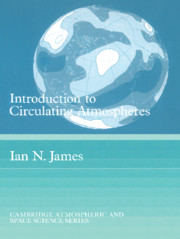Book contents
- Frontmatter
- Contents
- Preface
- Notation
- l The governing physical laws
- 2 Observing and modelling global circulations
- 3 The atmospheric heat engine
- 4 The zonal mean meridional circulation
- 5 Transient disturbances in the midlatitudes
- 6 Wave propagation and steady eddies
- 7 Three-dimensional aspects of the global circulation
- 8 Low frequency variability of the circulation
- 9 The stratosphere
- 10 Planetary atmospheres and other fluid systems
- Appendix: Solutions to Problems
- Bibliography
- References
- Index
5 - Transient disturbances in the midlatitudes
Published online by Cambridge University Press: 14 January 2010
- Frontmatter
- Contents
- Preface
- Notation
- l The governing physical laws
- 2 Observing and modelling global circulations
- 3 The atmospheric heat engine
- 4 The zonal mean meridional circulation
- 5 Transient disturbances in the midlatitudes
- 6 Wave propagation and steady eddies
- 7 Three-dimensional aspects of the global circulation
- 8 Low frequency variability of the circulation
- 9 The stratosphere
- 10 Planetary atmospheres and other fluid systems
- Appendix: Solutions to Problems
- Bibliography
- References
- Index
Summary
Timescales of atmospheric motion
The circulation of the atmosphere is intrinsically unsteady; fluctuations on all timescales are observed. In the last chapter, it was shown that the fluxes of temperature, momentum, and so on, carried by such transients play an important part in determining the time mean circulation of the atmosphere. Our task in this chapter will be to describe the transients on various timescales, and to discuss the mechanisms which can give rise to transient behaviour. Just as the atmosphere contains a wide range of spatial scales, from the molecular to the global, so the atmospheric circulation exhibits a wide range of timescales, ranging from timescales of just a few seconds associated with the overturning of small turbulent eddies, to geological timescales for major climate changes.
Some of the frequencies observed are directly related to the frequencies of periodic forcings. For example, diurnal and semi-diurnal variations of temperature and wind are associated with the diurnal variation of solar heat input. These ‘thermal tides’ are important at high levels in the atmosphere and can be detected in the lower atmosphere. More importantly for our purposes, the annual cycle of radiative forcing has a profound effect on large scale atmospheric circulation. This seasonal cycle of meteorological quantities affects nearly all parts of the globe.
But in addition to these externally imposed periods, the atmospheric flow itself generates all kinds of timescales internally.
- Type
- Chapter
- Information
- Introduction to Circulating Atmospheres , pp. 112 - 163Publisher: Cambridge University PressPrint publication year: 1994



